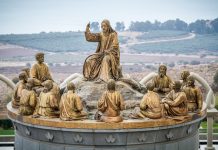
by Kate Ristow
For an idea on how to help your learners connect the virtues with Beatitude living, see the end of this article.
Blessed are the poor in spirit, for theirs is the kingdom of heaven.
Blessed are they who mourn, for they will be comforted.
Blessed are the meek, for they will inherit the land.
Blessed are they who hunger and thirst for righteousness, for they will be satisfied.
Blessed are the merciful, for they will be shown mercy.
Blessed are the clean of heart, for they will see God.
Blessed are the peacemakers, for they will be called children of God.
Blessed are they who are persecuted for the sake of righteousness, for theirs is the kingdom of heaven.
Blessed are you when they insult you and persecute you and utter every kind of evil against you [falsely] because of me. Rejoice and be glad, for your reward will be great in heaven.
—Matthew 5:3-12
Imagine what it must have been like 2,000 years ago to be part of a large crowd listening to an itinerant preacher describe the qualities and actions of people especially blessed by God—among them, the poor in spirit, the meek, the persecuted. Even today, we scratch our heads and wonder at the paradoxes found in Jesus’ Beatitudes.
That is why this year’s University of Dayton Catechist Formation Series in Association with CATECHIST Magazine was a golden opportunity to deepen our adult understanding of Jesus’ Sermon on the Mount. If you have not read the series yet, do so now. The seven articles will enrich your understanding of how Jesus calls his disciples to live.
This article focuses on ideas for bringing to life in your classroom the themes found in the series. As you begin long-range planning for fall, think about how you can incorporate these suggestions into your junior-high sessions next year.
Bringing Justice Now
In the September issue, David Wheeler-Reed tells us that no one truly understood the term “poor in spirit” in the first Beatitude until the discovery of the Dead Sea Scrolls. Wheeler-Reed tells us that these manuscripts reveal that the term refers to those “‘who have been beaten down by the vicissitudes of life’”; in other words, people who have experienced the “‘injustice’ of an unfair world.”
Invite your learners to create on the board a list of people or groups they are aware of that can be described as beaten down or treated unfairly. Possible responses may include those who are homeless, unemployed, or elderly; people with terminal diseases; victims of natural or human-made disasters; and so forth. Wheeler-Reed emphasizes the importance of aligning ourselves with the poor in spirit by identifying them and then “lending a helping hand to anyone in need.”
Work with your class to plan an activity to serve or assist the poor in spirit. Make sure the activity is age appropriate. For example, if students want to visit a soup kitchen, arrange for them to have behind-the-scene responsibilities—cutting up vegetables, setting tables, washing pots and pans. It is not appropriate for elementary or middle-school students to mingle with guests at a soup kitchen.
Teaching the Beatitudes
Sean Reynolds’ October article emphasizes that the Beatitudes are not meant to replace the Ten Commandments. Rather, he says, the “Beatitudes perfect the Commandments.” He suggests seven ways to teach the Beatitudes, one inspired by Pope Benedict XVI: studying the saints.
Invite students to work in groups to study books about the lives of the saints. If they have access to computers, use the internet to search biographies of saints. Direct each group to find a saint who personifies one of the Beatitudes and report their findings back to the class. Insist that groups defend their choices and explain how the saints they chose lived a specific Beatitude.
Called to Discipleship
In the December issue, Susan K. Sack points out that “Beatitude discipleship” is rooted in Scripture and prayer. Sack emphasizes that prayer is “an expression of our relationship with God.” She points out that prayer is difficult to define because it takes so many forms, but notes surveys indicating that “almost everyone prays in at least some rudimentary fashion.”
Students will enjoy creating and conducting a Prayer Survey. Make this an all-class activity. First, have students brainstorm different ways of praying, such as traditional prayer, spontaneous prayer, meditation, praying with Scripture, intercessional prayer, devotional prayer (the Rosary, the Stations of the Cross), and so forth. Label the first column “Ways to Pray” and list these ways in the column, adding an “Other” category at the bottom of the list. The second column might be labeled “How often do you pray in this way?” and the third column can be labeled “Do you usually pray this way alone or with others?”
Invite a volunteer to create the survey form on a home computer and bring it to the next session. Duplicate five to ten copies for each student. Have students survey family members, relatives, and neighbors. Encourage each student to complete a survey as well. Ask them to compile their survey results and to be prepared to report what they learned at your next class.
Breaking Open the Beatitudes
Jane Bensman’s article titled “The Ladder of the Beatitudes: Beginning the Ascent” in the January issue explores the meaning of the first four Beatitudes. She points out that climbing each ladder “rung” of the Beatitudes, beginning with the first one, prepares us for putting the next one into practice.
Bensman’s article takes us through this progression. First, our poverty of spirit creates in us a quality necessary for discipleship—dependence on God. As Bensman goes on to explain the next three Beatitudes, she always returns to this as bedrock: We must rely on, count on, and depend on God first and foremost.
The article concludes with Bensman comparing the virtues needed to live the Beatitudes as muscles that must be exercised. Discuss with students—who are at an age where they are striving for independence—why dependence on God is an important virtue for Catholics to cultivate. Have them suggest specific ways they can grow in their trust in and reliance on Jesus.
The Desire to Be Happy
In the February article, “The Ladder of the Beatitudes II: Embracing the Challenge,” Norm Rich recalls St. Gregory of Nyssa’s fourth-century description of the Beatitudes as a staircase ascending to God. Rich’s article examines what it means to be merciful, pure of heart, and seekers of peace.
Ask for volunteers to name their goals in life. As Rich states, these may include wealth, fame, or power. Help your junior-high students understand that we want to achieve these things because we believe they will make us happy. Point out the conclusion Rich makes early in his article: The path to happiness does not lie in our worldly desires, but in living a life of love.
Read aloud the stories of Ronald Cotton and Sr. Dorothy Stang from Rich’s article to illustrate how the Beatitudes can be lived. Have students recall people in history whose actions reflected the kind of Beatitude love that Rich describes. Examples might include Blessed Mother Teresa of Calcutta, Rosa Parks, or Staff Sgt. Salvatore Giunta, who won the Medal of Honor in 2010 for his bravery in combat in Afghanistan in 2007. (If you do not know Giunta’s story, find it on the internet and share it with the class.) You might also consider having students look though local papers for stories of people who are examples of living for others, as the Beatitudes call us to do.
The Art of Discernment
The March article by Rev. James Schimelpfening, SM, focused on developing a discerning heart—a “heart that strives to know…the mind, heart, and ways of God.”
Schimelpfening emphasizes the importance of what he calls “deep listening” so that we can hear God’s call in our lives.
This is a perfect opportunity to address the clamor—the constant noise—we encounter daily: ring tones, iPods, television, white noise, and other sounds students can add to the list. Emphasize that we need silent hearts and minds to hear God speaking to us.
Suggest to the kids that they plan a weeklong “Take Ten” campaign in which they strive for exterior and interior silence for ten minutes each day. Brainstorm visual aids they might use to advertise the program—posters, wrist bands, e-mails, or text “ads,” and the like—and have the class vote on the most effective tools. Supply materials for students to work in groups to create their promotional materials.
Plan the “Take Ten” campaign at least a month in advance so that students have time to heighten awareness and get the word out. Afterwards, discuss with students their personal responses to the campaign and how they feel it helped them and others to grow as disciples of Jesus.
Building a Beatitude Culture
Sister Angela Ann Zukowski’s article in this issue of CATECHIST (see page 50) is chock-full of practical and creative ideas for helping students, faculty, and the parish community to embrace the Beatitudes as a way of life. Follow Sr. Angela’s “Best Practices” suggestions for developing a pastoral plan. I was particularly struck by Sister’s explanation of the original meaning of the word Baptism (Baptizo).
To help students understand the call to live the Beatitudes, divide the class into two groups and have them prayerfully proclaim Matthew 5:3-12—antiphonally, with the groups alternating verses. Then call students forward, one at a time, and bless them by tracing the sign of the cross on their foreheads using oil or blessed water. After all have been blessed, extend your arms over the class and have them echo the following prayer, one line at a time: “Lord, you point the way to happiness. Guide us always in living your Beatitudes.”
Adapting the Monthly Study Guide
The questions and exercises in the monthly Study Guides that accompany each article are a wonderful springboard for classroom activities. Get started with the suggestions below.
September: Build on the Wheeler-Reed’s suggestion in the introduction to his study guide to meditate on Matthew 5:3-12 by challenging students to memorize the Beatitudes. Remember that “learning by heart” is cited in the National Directory for Catechesis as an effective means of catechesis (see NDC, n. 29F).
October: Have students complete Exercise 2 by working in small groups to create examinations of conscience based on the Beatitudes. Conclude your sessions over the next several weeks by having a group prayerfully read aloud their examinations to the class.
November/December: Build on Discussion/Reflection Question 1 by inviting a member of your parish RCIA team to speak to your students about how this process works in your parish. Ask your guest to emphasize how the RCIA promotes Beatitude discipleship.
January: As an alternative to Exercise 2, help your students appreciate how your parish ministries are a vibrant sign of the Beatitudes in action. Using several recent editions of the parish bulletin or a duplicated list of parish ministries, have students work in small groups to identify the specific ways different ministries live out one or more of the Beatitudes. Follow up on this activity by having students write notes of appreciation to the members of several ministries, thanking them for their example of living as Beatitude communities through their service to others.
February: Follow up on Exercise 2 by recalling that we can seek and receive forgiveness for our sins in the Sacrament of Reconciliation. Review the process for celebrating the Individual Rite of Reconciliation. Arrange for a priest to celebrate the Sacrament with your class during an upcoming session.
March: Exercise 1 suggests researching different methods for practicing discernment. One consistent activity you can practice during class is meditation. Invite students to begin by closing their eyes and breathing deeply and slowly, quieting their minds and bodies. After a few moments of stillness, proclaim one of the Beatitudes aloud (for example, Matthew 5:3: “Blessed are the poor in spirit, for theirs is the kingdom of heaven”). Let the words “steep” for a few moments. Then quietly ask questions like the following, pausing for a minute or two after each: “What does it mean for me to be poor in spirit? How do I show that I depend on God? How is God calling me to help people who are in need?” Set aside time in consecutive class sessions to meditate on each of the Beatitudes.
April/May: Extend Exercise 1 by inviting each student to write a personal Mission Statement that declares his or her commitment to live the Beatitudes and identifies specific actions and attitudes he or she will undertake to become a Beatitude person. Post completed Mission Statements on a bulletin board in a public area of the parish.
Kate Ristow, Contributing Editor to CATECHIST, has worked in catholic publishing for over 25 years as a national speaker and writer, building on a wealth of experience in the religious formation of children and catechists in both parish and Catholic school programs.
Connecting the Virtues with Beatitude Living
This activity is designed as a follow up to a lesson on the Beatitudes. Before introducing it to your class, go to virtuesproject.com and use the Site Map to locate “What Are the Virtues?” There you will find a list of the 52 virtues taught in this popular program. Duplicate the list so that you have enough copies for the students to share in small groups. Explain to the class that we can think of the virtues as muscles that strengthen us to live the Beatitudes, as Jane Bensman’s January article stated.
Help students recall that virtues are spiritual habits that help us do what is right and avoid doing what is wrong. Assign two Beatitudes to each group and invite each group to choose three virtues that will help them live each of their assigned Beatitudes. Afterward, allow time for members of each group to explain their choices to the class.
Copyright 2011, Bayard, Inc. All rights reserved. This article is protected by United States copyright and other intellectual property laws and may not be reproduced, rewritten, distributed, redisseminated, transmitted, displayed, published or broadcast, directly or indirectly, in any medium without the prior written permission of Bayard, Inc.
This article was written by the Catechist Staff and appeared in Catechist magazine, March 2011.
Image Credit: Shutter Stock 41771077




